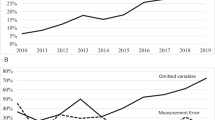Abstract
In order to diminish size distortions of the t test in a time series linear specification, Agiakloglou (Agiakloglou in Empir Econ, 45(3):1361–1366, 2013) proposed to (1) include the first lag of the dependent variable as a regressor or (2) estimate it using the first differences of the variables. He provided finite-sample evidence to support his proposal. In this paper, we extend the Monte Carlo experiment to different data-generating processes and calculate the asymptotic behavior of the modified specifications. We show that including the lag of the dependent variable as a regressor reduces size distortions when the variables are driftless unit roots, but this approach does not hold under the presence of long memory, nonlinearities, or structural breaks.
Similar content being viewed by others
Notes
The size distortion reductions also occur for different specifications of the 3-R SETAR, and for other persistence parameter values in ARFIMA models, as can be seen in Tables 14 and 21, respectively, in the supplementary material.
References
Agiakloglou C (2013) Resolving spurious regressions and serially correlated errors. Empir Econ 45(3):1361–1366. doi:10.1007/s00181-012-0647-4
Granger CW, Newbold P (1974) Spurious regressions in econometrics. J Econom 2(2):111–120
Hamilton JD (1994) Time series analysis. Princeton University Press, Princeton
Kolev GI (2011) The ‘spurious regression problem’ the classical regression model framework. Econ Bull 31(1):925–937
Martínez-Rivera B, Ventosa-Santaulària D (2012) A comment on ‘is the spurious regression problem spurious?’. Econ Lett 115(2):229–231
McCallum BT (2010) Is the spurious regression problem spurious? Econ Lett 107(3):321–323
Phillips PC (1986) Understanding spurious regressions in econometrics. J Econom 33(3):311–340
Ventosa-Santaulària D (2009) Spurious regression. J Probab Stat 2009. doi:10.1155/2009/802975
Yule GU (1926) Why do we sometimes get nonsense-correlations between time-series? a study in sampling and the nature of time-series. J R Stat Soc 89:1–63
Acknowledgments
V.-V acknowledges support from CREATES - Center for Research in Econometric Analysis of Time Series (DNRF78), funded by the Danish National Research Foundation.
Author information
Authors and Affiliations
Corresponding author
Electronic supplementary material
Below is the link to the electronic supplementary material.
Appendices
Appendix 1: Proof of Theorem
1. Model 2: Given that \(x_t\) and \(y_t\) are unit root processes and the regression is estimated using the variables in first differences, the results in part (1) of the Theorem are straightforward. First differences of both unit root processes behave as simple iid I(0) independent processes. Therefore, classic econometric theory applies, so we know that, under the null, the t ratios converge to a standard normal random variable (rv). Note that the standard Brownian motion, \(w_{x,y}(\cdot )\), stated in the first part of the Theorem, is precisely a standard Normal rv. Note too that, when the differenced variables are not iid but rather stationary ARMA processes (for instance), typical autocorrelation ensues.
2. Model 3: We present a guide as to how to obtain the asymptotic expression of the estimates and their associated t ratios using OLS where the variables \(y_t\) and \(x_t\) are generated as independent unit root processes, and specification 3 is estimated. Let \(\hat{\varTheta }=(\hat{\alpha },\hat{\beta },\hat{\delta })'\):
where,
and,
The estimated parameters \(\hat{\alpha }\), \(\hat{\beta }\), and \(\hat{\delta }\) and their corresponding t ratios are functions of the following expressions (initial conditions are set as \(x_{0}=y_{0}=0\)). We use well-known asymptotic results (available, inter alia, in Hamilton (1994), 1994, Proposition 17.1, p.486). Let \(z=y,x\) and \(\xi _{zt}=\sum _{i=1}^{t}{u_{zi}}\):
where \(\omega _{z}(1)\) is a standard brownian motion and \(\mathop {\rightarrow }\limits ^{D}\) denotes convergence in law. The later results allow us to fill the OLS matrices and then compute the parameter estimates and the t statistic associated with each. Note that we also require sums involving the lagged dependent variable, which can be easily obtained:
Replacing the sums that appear in the OLS formulae with the above asymptotic expressions and letting \(T\rightarrow \infty \) yields the results stated in the Theorem. The algebra involved is cumbersome but does not present any particular complication. Codes in algebraic manipulation programs with the calculations are available upon request.
Appendix 2: Data-generating processes
See Table 4.
Rights and permissions
About this article
Cite this article
Ventosa-Santaulària, D., Vera-Valdés, J.E. & Martínez-Olmos, A.I. A comment on ‘resolving spurious regressions and serially correlated errors’. Empir Econ 51, 1289–1298 (2016). https://doi.org/10.1007/s00181-015-1035-7
Received:
Accepted:
Published:
Issue Date:
DOI: https://doi.org/10.1007/s00181-015-1035-7




